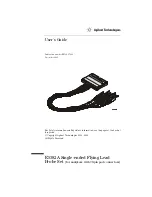
A
User’s Guide
Publication number E5382-97002
December 2005
For Safety information and Regulatory information, see the pages at the back of
this guide.
© Copyright Agilent Technologies 2002, 2005
All Rights Reserved.
E5382A Single-ended Flying Lead
Probe Set
(for analyzers with 90-pin pod connectors)
Summary of Contents for E5382A
Page 4: ...4 Contents ...
Page 5: ...1 General Information ...
Page 13: ...2 Operating the Probe ...
















